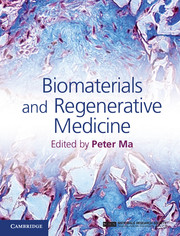Book contents
- Frontmatter
- Contents
- List of contributors
- Preface
- Part I Introduction to stem cells and regenerative medicine
- Part II Porous scaffolds for regenerative medicine
- Part III Hydrogel scaffolds for regenerative medicine
- Part IV Biological factor delivery
- Part V Animal models and clinical applications
- 25 Bone regeneration
- 26 Biomaterials for engineered tendon regeneration
- 27 Advancing articular cartilage repair through tissue engineering: from materials and cells to clinical translation
- 28 Engineering tissue-to-tissue interfaces
- 29 Models of composite bone and soft-tissue limb trauma
- 30 Tooth development and regeneration
- 31 Dentin–pulp tissue engineering and regeneration
- 32 Dental enamel regeneration
- 33 Hair follicle and skin regeneration
- 34 In-vitro blood vessel regeneration
- 35 Stem cells for vascular engineering
- 36 Cardiac tissue regeneration in bioreactors
- 37 Bladder regeneration
- Index
- References
29 - Models of composite bone and soft-tissue limb trauma
from Part V - Animal models and clinical applications
Published online by Cambridge University Press: 05 February 2015
- Frontmatter
- Contents
- List of contributors
- Preface
- Part I Introduction to stem cells and regenerative medicine
- Part II Porous scaffolds for regenerative medicine
- Part III Hydrogel scaffolds for regenerative medicine
- Part IV Biological factor delivery
- Part V Animal models and clinical applications
- 25 Bone regeneration
- 26 Biomaterials for engineered tendon regeneration
- 27 Advancing articular cartilage repair through tissue engineering: from materials and cells to clinical translation
- 28 Engineering tissue-to-tissue interfaces
- 29 Models of composite bone and soft-tissue limb trauma
- 30 Tooth development and regeneration
- 31 Dentin–pulp tissue engineering and regeneration
- 32 Dental enamel regeneration
- 33 Hair follicle and skin regeneration
- 34 In-vitro blood vessel regeneration
- 35 Stem cells for vascular engineering
- 36 Cardiac tissue regeneration in bioreactors
- 37 Bladder regeneration
- Index
- References
Summary
Introduction
Severe limb trauma often results in substantial injuries to multiple tissue types, including bone, skeletal muscle, nerve, and vasculature. These injuries generally present increased clinical challenges and frequently cannot be managed with conventional reconstruction techniques. Furthermore, due to the complex nature of these injuries, there is no real consensus on intervention strategies [1–3]. Given the inherent severe and pervasive tissue damage, multistage treatment is routinely required, and patients are typically encumbered with diminished long-term function even if limb salvage and reconstruction are successful [4, 5].
Extremity trauma remains the predominant type of combat casualty for US armed forces members engaged in ongoing military conflicts, a continuation of historical trends. Explosive munitions are the primary cause of these injuries [6, 7], resulting in penetrating blast wounds with large zones of injury that encompass multiple tissue types, and, notably, a high incidence of bone and soft-tissue trauma [6] (Figure 29.1). High-energy trauma incidents, such as motor vehicle collisions, produce an additional civilian patient population. Although passenger survival in these incidents has increased with improved engineering of safety features, severe extremity trauma remains common [8, 9].
- Type
- Chapter
- Information
- Biomaterials and Regenerative Medicine , pp. 534 - 554Publisher: Cambridge University PressPrint publication year: 2014
References
- 2
- Cited by



